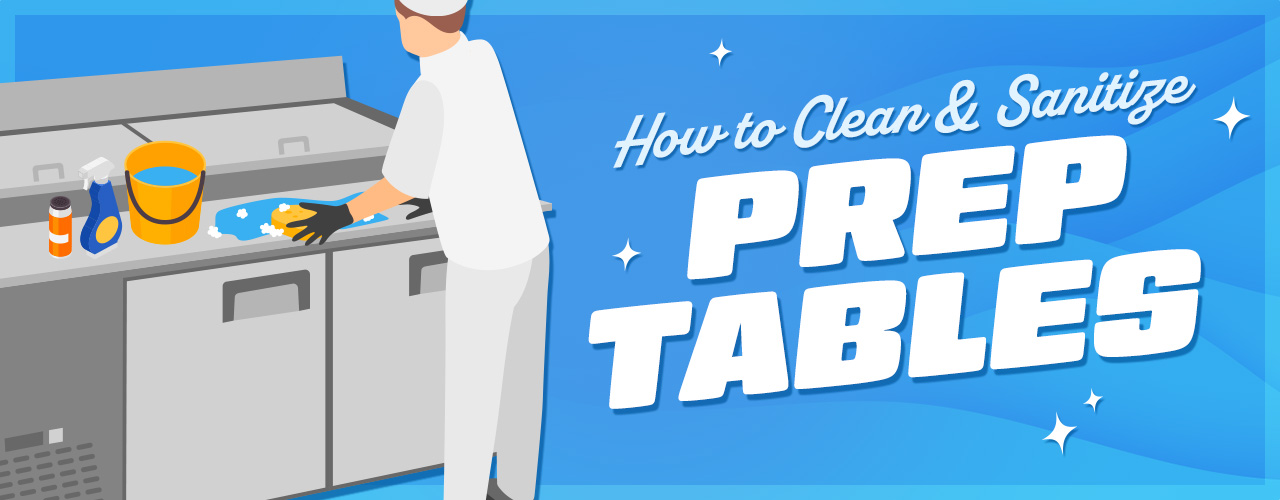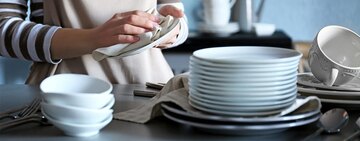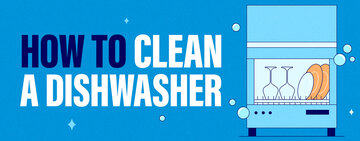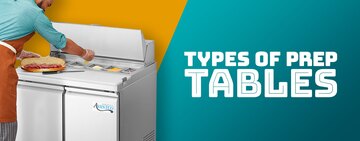
Maintaining a clean and sanitary prep table is essential in any commercial kitchen. Chefs use prep tables to prepare ingredients, assemble dishes, and store food items, making their cleanliness a critical component of food safety. Proper cleaning and sanitizing procedures help prevent cross-contamination, foodborne illnesses, and the spread of bacteria and germs. By following a regular cleaning and sanitizing routine, you can ensure the safety of your customers and the quality of your food products. Learn how to clean and sanitize a prep table and maintain a commercial kitchen up to health inspection standards.
Shop All Refrigerated Prep TablesSupplies Needed for Cleaning and Sanitizing a Prep Table

There are certain tools and supplies you need to have readily available to maintain a sanitary prep table in your commercial kitchen. Here is what you will need to ensure your prep table is thoroughly cleaned and sanitized:
- Cleaning Cloths: You need high-quality cleaning cloths for wiping down surfaces and removing debris from your prep table. Choose durable cleaning cloths to ensure effective sanitation.
- Microfiber Cleaning Cloths for Stainless Steel: For stainless steel prep tables, microfiber cleaning cloths are ideal for gently cleaning and polishing the surface without leaving streaks or scratches.
- Mild Detergent/Dishwashing Soap: A mild detergent or dishwashing soap is ideal for cleaning the surface of the prep table. Choose a product that is safe for food contact surfaces.
- OEM-Approved Sanitizing Solution: An OEM-approved sanitizing solution is necessary to effectively eliminate bacteria and other harmful pathogens from the prep table while also not damaging its surface. Follow the manufacturer's instructions for proper dilution and application.
- Squeegee: A squeegee quickly removes excess water and cleaning solution from the surface of the prep table. This tool helps to prevent streaks and water spots.
- Nylon Cleaning Pad for Stainless Steel A nylon cleaning pad designed for stainless steel surfaces can help gently scrub away stubborn stains and residue without scratching the material.
- Stiff Bristle Brush: A stiff bristle brush is useful for scrubbing hard-to-reach areas and removing buildup in crevices and corners of the prep table.
Step-by-Step Guide to Cleaning and Sanitizing a Prep Table

It is important to understand the key differences between cleaning and sanitizing. Cleaning involves the removal of visible dirt, debris, and grease from the surface while sanitizing is the process of reducing the number of bacteria and other pathogens to safe levels. To effectively clean and sanitize a prep table, you must use separate cleaning and sanitizing solutions. Using the same solution for both cleaning and sanitizing can be ineffective and may not fully eliminate harmful bacteria.
How to Clean a Prep Table
To effectively clean a prep table, you must follow a systematic approach that ensures every nook and cranny is addressed. Once complete, your table is ready to be sanitized. We provide instructions for the sanitation process following the cleaning list.
- Remove Food Products and Food Bins: Before starting the cleaning process, remove all food products and food bins from the prep table so the surface is clear and ready for cleaning.
- Clean the Condenser Coil: If you have a refrigerated prep table, you must clean its condenser coil monthly or as needed. A dirty condenser coil can affect the unit's efficiency and lead to potential food safety issues.
- Remove Debris: Use a brush or cloth to remove any food debris, crumbs, or spills from the prep table surface. Pay attention to corners and crevices where debris may accumulate.
- Wipe Down and Disinfect: Use an OEM-approved disinfecting solution or a mixture of water and mild detergent to wipe down the entire surface of the prep table. Ensure that all areas, including edges and undersides, are thoroughly cleaned.
- Clean and Disinfect Cutting Boards: If the prep table has cutting boards, remove and wash them separately. Follow the manufacturer’s cleaning and disinfecting instructions before placing them back on the prep table.
- Maintain Gaskets: Check the gaskets of the prep table regularly for any signs of wear or damage. Clean the gaskets with a mild detergent and water solution to remove dirt and debris.
How to Sanitize a Prep Table
Once your prep table is clean, follow these five steps to sanitize it:
- Wipe: Remove all visible debris of food or any waste on the surface, ensuring the surface is clear of any contaminants before proceeding with the sanitization process.
- Wash: Prepare soapy warm water and scrub the table surface thoroughly to dislodge any grease or food particles that may be clinging to the surface.
- Rinse: Using clean water, rinse the table to remove any detergent residue that may be left behind.
- Soak in Sanitizing Solution: Select an OEM-approved sanitizing solution and follow the manufacturer's instructions for dilution and contact time to ensure effective sanitization.
- Air Dry: Allow the surface to air dry completely before using the prep table again.
Tips for Cleaning a Stainless Steel Prep Table

By following these tips, you can ensure that your stainless steel prep table remains clean, sanitized, and in top condition for food preparation in your commercial kitchen.
- Follow the manufacturer's instructions when selecting a cleaning solution to prevent any damage to the surface of the prep table.
- A wet cloth and mild detergent are often the best choices for removing dirt, grease, and food residue from stainless steel.
- Chlorine-based cleaners are not suitable for stainless steel prep tables as they will damage the stainless steel finish.
- When wiping down your prep table, always wipe in the direction of the finish to prevent streaks and maintain the appearance of the stainless steel.
- Never use rough abrasive sponges or steel wool as these materials can scratch the surface, leading to potential corrosion and bacterial growth.
Why Must Prep Tables Be Cleaned and Sanitized Between Uses?
Cleaning and sanitizing prep tables between uses is essential for complying with health regulations, preventing cross-contamination, maintaining food quality, and extending equipment lifespan. By prioritizing cleanliness and sanitation, businesses can ensure the safety and satisfaction of their customers while upholding the highest standards of foodservice.
- Comply with Health Regulations: Health departments require commercial kitchens to adhere to strict cleanliness and sanitation standards to prevent foodborne illnesses. Regularly cleaning and sanitizing prep tables is a fundamental aspect of food safety protocols and is necessary to comply with health regulations and maintain a clean and hygienic kitchen environment.
- Prevent Cross-Contamination: Prep tables are used to handle a variety of ingredients, including raw meats, vegetables, and ready-to-eat foods. Failure to clean and sanitize the prep table between uses can lead to cross-contamination, where harmful bacteria from one food item can transfer to another, posing a serious health risk to customers.
- Maintain Food Quality: Residue from previous food items left on the prep table can affect the taste and quality of the next dish prepared on it. Cleaning and sanitizing the prep table between uses helps maintain the freshness and integrity of the ingredients, ensuring that each dish meets the highest standards of quality.
- Extend Equipment Lifespan: Proper cleaning and sanitizing practices help extend the lifespan of prep tables and other kitchen equipment. Regular maintenance and sanitation prevent the buildup of grime, grease, and bacteria, reducing the risk of corrosion and wear and tear on the equipment.
Prep Table Sanitation FAQ

We answer some of the most common questions restauranteurs have as they clean and sanitize their prep tables below.
What Is the Most Important Step When Preparing the Sanitizing Solution?
The most important step when preparing the sanitizing solution is to follow the manufacturer's instructions carefully. Different sanitizers require specific concentrations to be effective against different types of bacteria and viruses. Use the correct tools, such as measuring cups and mixing containers, to prepare the sanitizing solution. Avoid using utensils that may react with the chemicals or alter the concentration of the solution.
Another key factor in preparing the sanitizing solution is to mix it with the appropriate amount of water and ensure that the water used is at the correct temperature. Most sanitizers work best in water that is at a specific temperature range, typically between 75 and 120 degrees Fahrenheit. Using water that is too hot or too cold can affect the effectiveness of the sanitizing solution.
How Can a Food Handler Determine If a Sanitizer Solution Is at the Correct Concentration?
By following these guidelines and taking proactive measures to monitor and maintain the correct concentration of sanitizer solutions, food handlers can uphold high standards of cleanliness and food safety in commercial kitchen environments.
- Follow Manufacturer's Instructions: The most reliable way to determine the correct concentration of a sanitizer solution is to follow the manufacturer's instructions. These instructions will specify the appropriate dilution ratio to achieve the desired concentration for effective sanitization.
- Use Test Strips: Test strips are a simple and effective tool for food handlers to verify the concentration of a sanitizer solution. These strips are typically color-coded and change color when dipped into the solution, indicating whether the concentration is within the recommended range.
- Adjustment and Retesting: If the sanitizer solution is found to be below or above the recommended concentration, food handlers should adjust the dilution ratio accordingly and retest the solution to ensure it meets the required concentration for effective sanitization.
- Consult Regulatory Guidelines: Food establishments are required to comply with regulatory guidelines regarding sanitizer concentrations. These guidelines, such as those provided by the FDA or local health departments, outline the acceptable concentration levels for different types of sanitizers.
How Often Should Sandwich Makers Sanitize Their Work Area?
Sandwich makers should sanitize their work area at least every four hours to maintain a safe and hygienic environment. According to the FDA Food Code, food contact surfaces, such as prep tables, cutting boards, and utensils, should be cleaned and sanitized every four hours during continuous use. In addition to the regular 4-hour sanitation schedule, sandwich makers should also sanitize their work area:
- Before starting a new task or after handling raw meat to prevent cross-contamination.
- After handling any potentially hazardous ingredients, such as eggs or seafood.
- When switching between different types of sandwiches to avoid flavor transfer and allergen cross-contact.
How to Clean & Sanitize Prep Tables Chart
After following the steps outlined above, your prep table should be clean and properly sanitized, ready for use in your commercial kitchen. Remember, maintaining a clean and sanitized prep table is essential for preventing cross-contamination and ensuring the safety of your food products. By incorporating regular cleaning and sanitizing practices into your kitchen routine, you can uphold high standards of hygiene and compliance with food safety regulations. Prioritize the cleanliness of your prep table to promote a healthy and efficient kitchen environment for you and your customers.






